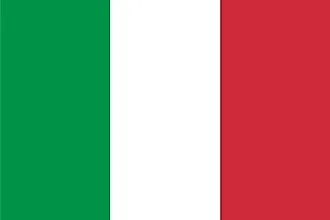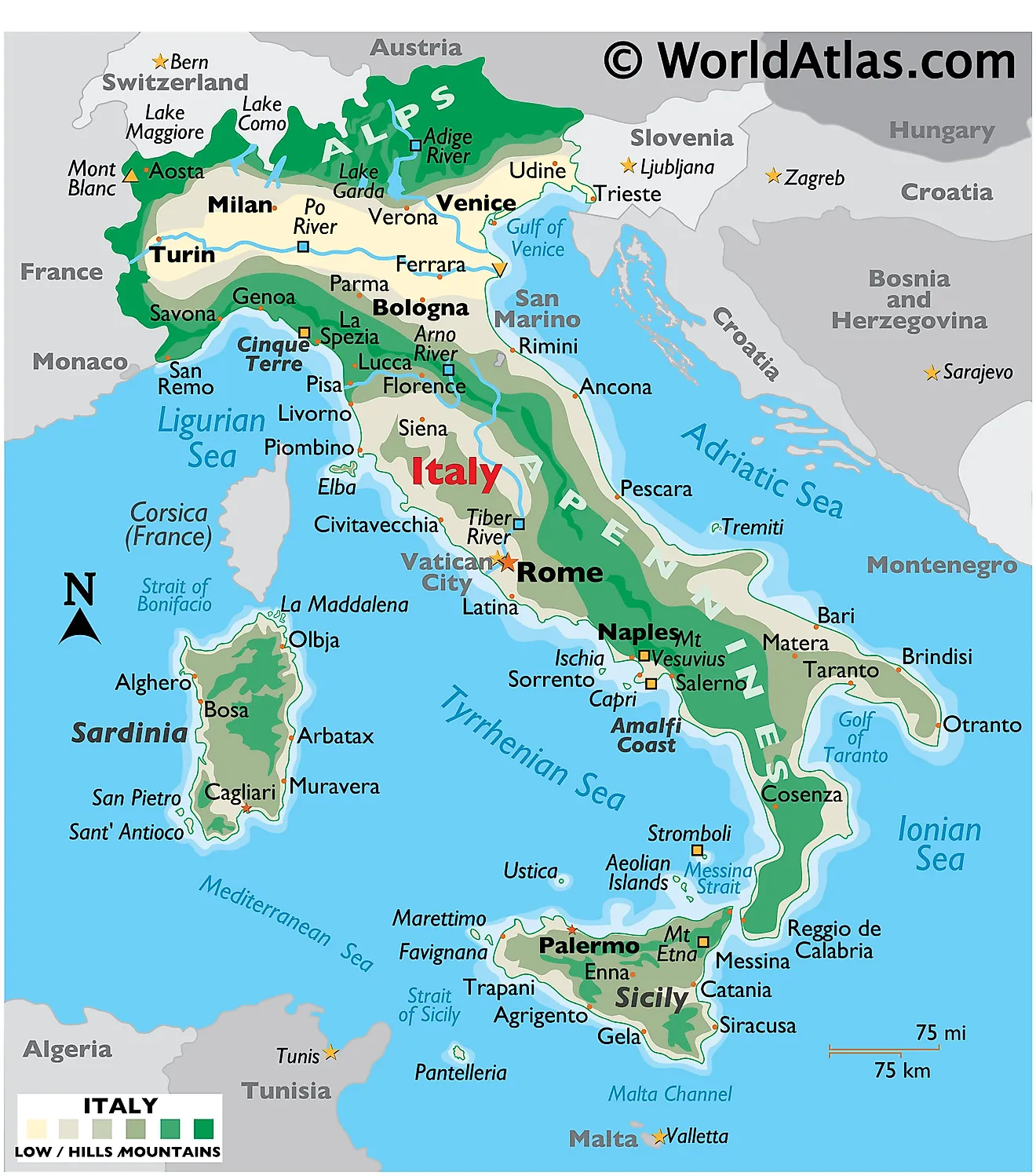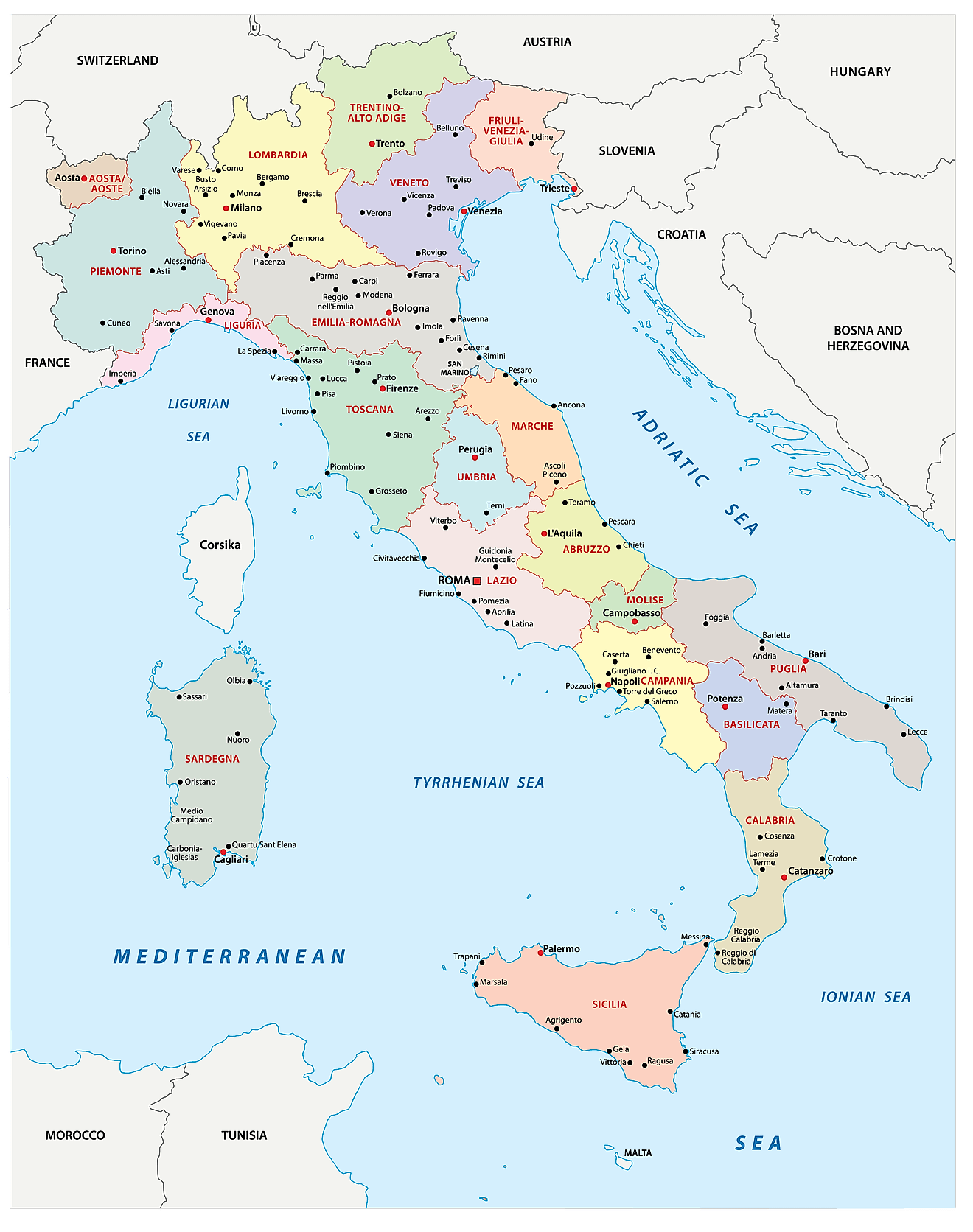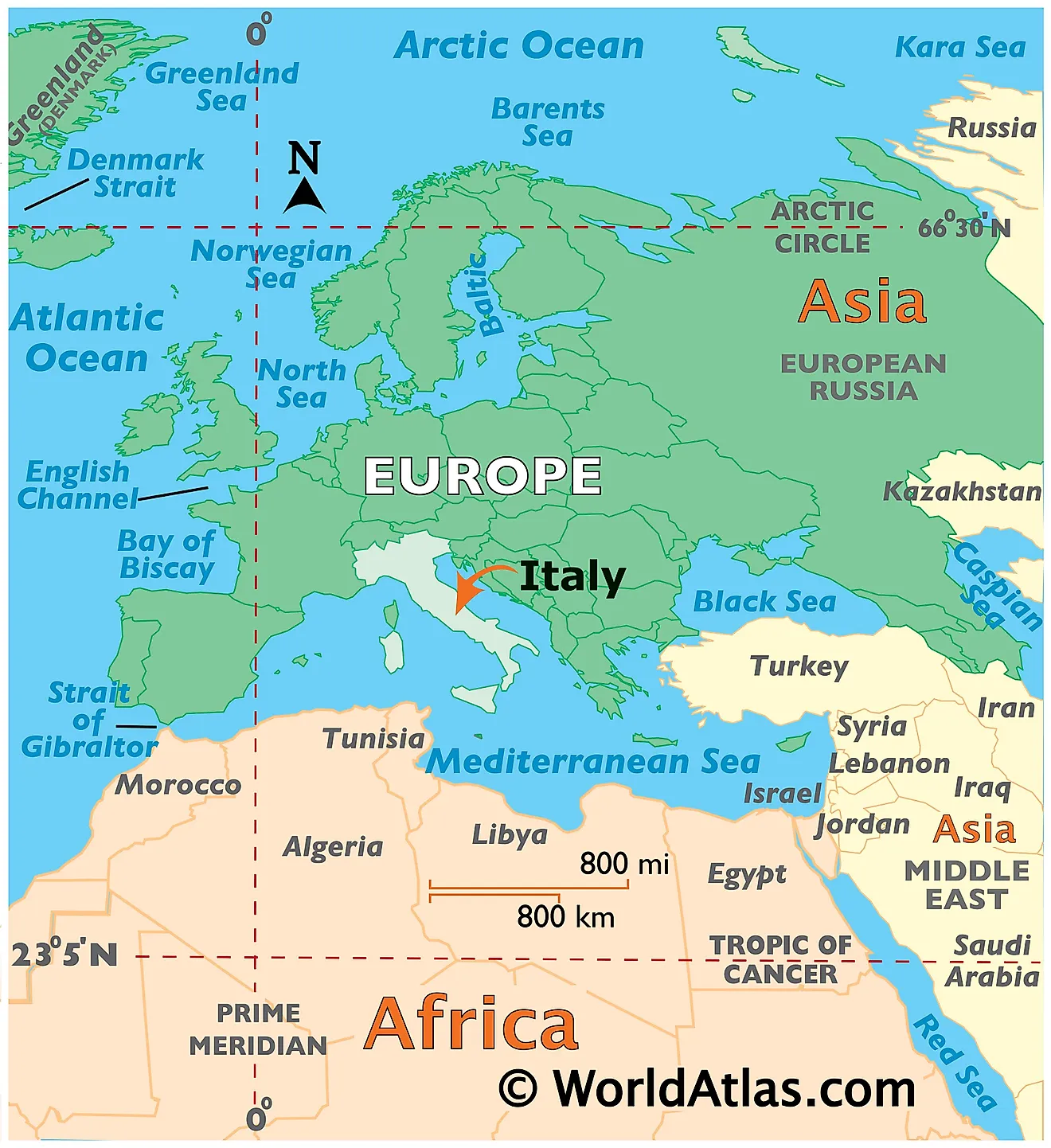Italy Maps & Facts (original) (raw)
Italy is a sovereign nation occupying 301,340 km2(116,350 sq mi) in southern Europe.
As observed on Italy's physical map, mainland Italy extends southward into the Mediterranean Sea as a large boot-shaped peninsula. This extension of land has forced the creation of individual water bodies, namely the Adriatic Sea, the Ionian Sea, the Ligurian Sea, and the Tyrrhenian Sea.
Varied ranges of the Alps dominate the country's northern reaches, a massive stretch of mountains that extends from France to Austria and then south along the Adriatic Sea. Italy's highest point near the summit of Mont Blanc (or Monte Bianco), a mountain it shares with France, rises to 4,748 m. A yellow triangle marks its position on the map above.
The beautiful and rugged Lake District of northern Italy includes many mountain lakes, with the major ones being Como, Garda and MaggioreThe Po River Valley is positioned directly south of the Alps and runs from Turin to Venice. Rising in the Alps, the Po River is Italy's longest, and the valley it dissects is the country's most fertile farmland.
As observed on the map above, the Apennine Mountains (a range of the Alps) from the Italian peninsula's backbone extend south through Italy, then directly beneath the narrow Strait of Messina to cover much of Sicily. These mountains consist of several chains, and they form the peninsula's watershed, as several rivers rise in the upper elevations, including the Arno and the Tiber.
About 30% of Italy's land area consists of plains with some low, marshy areas, especially along the Adriatic Sea, from Ancona north to Venice. The coastline of the country features numerous large and small bays, as well as gulfs.
The Amalfi Coast south of Naples and the Cinque Terra to the north of Pisa offers some of the most spectacular coastal scenery imaginable as steep rocky slopes rush down to the sea, and tiny villages with colourful houses pack much of the cliffs.
Italy is renowned for its many rugged islands, most volcanic in origin. Significant ones include the large islands of Sardinia and Sicily and the smaller islands of Capri, Elba, Ischia, and the Aeolian Islands group. Much of Italy is volcanic in origin, and today a few of its many volcanoes are active, including Sicily's Mt. Etna, Stromboli in the Aeolian Islands. Volcanologists are constantly monitoring Mt. Vesuvius near Naples, as it has the potential to erupt at any time.
Regions of Italy Map
Italy (officially, the Italian Republic) comprises of 15 regions (regioni, singular - regione) and 5 autonomous regions (regioni autonome, singular - regione autonoma). The regions are: Abruzzo, Basilicata, Calabria, Campania, Emilia-Romagna, Lazio (Latium), Liguria, Lombardia, Marche, Molise, Piemonte (Piedmont), Puglia (Apulia), Toscana (Tuscany), Umbria, and Veneto. The autonomous regions are: Friuli Venezia Giulia; Sardegna (Sardinia); Sicilia (Sicily); Trentino-Alto Adige (Trentino-South Tyrol) or Trentino-Suedtirol (German); Valle d'Aosta (Aosta Valley) or Vallee d'Aoste (French).
The regions are further subdivided into 107 provinces, of which 14 are metropolitan cities. The different provinces comprise 7960 municipalities (comuni).
With an area of 301,340 sq. km, Italy is the 3rd most populous member state of EU. Located in the central-western portion of the Italian Peninsula, along the shores of the Tiber River, Rome is the capital and the largest city of Italy. It is also the country’s most populated city and the 4th most populous city in EU. Rome is often referred as ‘capital of two states’ – as Vatican City is an independent state within the boundaries of Rome.
Where is Italy?
Italy is located in South-central Europe on the Apennine Peninsula. It is positioned both in the Northern and Eastern hemispheres of the Earth. Italy shares its borders with Switzerland and Austria in the north, with Slovenia in the northeast and with France in the northwest. Vatican City and San Marino are the two enclaved sovereign states within Italy. With its southern boundary extending into the Mediterranean Sea, the boot shaped Italian Peninsula is bordered by the Adriatic Sea in the east, the Sea of Sicily in the south, the Ionian Sea in the southeast, the Ligurian Sea, and the Tyrrhenian Sea in the southwest. The two largest Mediterranean Islands -Sardinia is located in the west and Sicily is to the south of Italy.
Italy Bordering Countries:Switzerland, Austria, San Marino, Slovenia, The Holy See [Vatican].
Regional Maps: Map of Europe
Outline Map of Italy
Key Facts
| Legal Name | Italian Republic |
|---|---|
| Flag |  |
| Capital City | Rome |
| 41 54 N, 12 29 E | |
| Total Area | 301,340.00 km2 |
| Land Area | 294,140.00 km2 |
| Water Area | 7,200.00 km2 |
| Population | 60,297,396 |
| Major Cities | Roma (Rome) (4,315,671) Milano (Milan) (3,154,570) Napoli (Naples) (2,179,384) Torino (Turin) (1,801,944) Bergamo (913,376) Palermo (849,687) Bologna (814,332) Firenze (Florence) (710,944) Padova (694,728) Genova (Genoa) (674,391) |
| Currency | Euros (EUR) |
| GDP | $2.00 Trillion |
| GDP Per Capita | $33,189.57 |
This page was last updated on February 25, 2021


